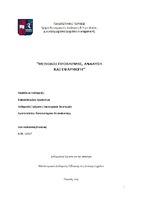Μέθοδοι πρόβλεψης, ανάλυση και εφαρμογή
Forecasting methods, analysis and application

View/
Subject
Πρόβλεψη ; Χρονοσειρές ; Καλλυντικά -- Βιομηχανία και εμπόριοKeywords
Μέθοδοι πρόβλεψηςAbstract
This master thesis is divided into two parts. In the first part, the forecasting methods, especially the analysis of time series methods are given, whereas, in the second part a few of these forecasting models are applied in the field of cosmetics and more specifically in L'oreal Hellas S.A.
More specifically, the first chapter is an introduction to the needs and uses of provisions, as well as an analysis of the current situation of the quantitative and technological forecasting methods and the steps needed to reach their configuration. Furthermore, in the second chapter, an overview of existing techniques and predictive models, depending on the available number and quality of data and an analysis of the qualitative forecasting methods is taken place. In the third chapter, special attention is given to the analysis of time series and the methods of simple average, simple moving average and simple weighted average with accompanied with examples for each case. Similarly, the fourth chapter analyzes the prediction method of the simple exponential smoothing with examples. The fifth chapter deals with the evaluation of error in forecasting, with the main means of error measurement along with the exponential smoothing with trend and seasonality, while the sixth chapter examines the forecasting method of linear moving average using examples, in order to better comprehend the technique. The seventh chapter, at the end of the first part of the theoretical framework of forecasting methods, studies linear exponential smoothing method with one parameter of the Brown model, with two parameters of the Holt model and seasonal data through the Winters model using examples.
Finally, in the second part the methods of moving average -3 & -5 periods of single exponential smoothing and Winters method are applied and compared for the company L'oreal Hellas S.A., in order to predict the demand for codes in the fields of skin care, maquillage, perfume and seasonal code. Through this comparison of prediction methods interesting conclusions arise, not only for the use and selection of the most appropriate method but also for further development.


